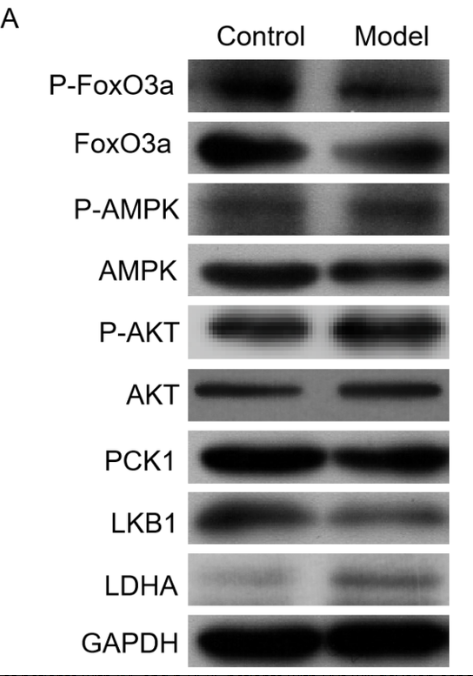PCK1 Antibody - #DF6770
| Product: | PCK1 Antibody |
| Catalog: | DF6770 |
| Description: | Rabbit polyclonal antibody to PCK1 |
| Application: | WB IHC IF/ICC |
| Reactivity: | Human, Mouse, Rat |
| Prediction: | Bovine, Sheep, Rabbit, Dog |
| Mol.Wt.: | 69kDa; 69kD(Calculated). |
| Uniprot: | P35558 |
| RRID: | AB_2838732 |
Related Downloads
Protocols
Product Info
*The optimal dilutions should be determined by the end user.
*Tips:
WB: For western blot detection of denatured protein samples. IHC: For immunohistochemical detection of paraffin sections (IHC-p) or frozen sections (IHC-f) of tissue samples. IF/ICC: For immunofluorescence detection of cell samples. ELISA(peptide): For ELISA detection of antigenic peptide.
Cite Format: Affinity Biosciences Cat# DF6770, RRID:AB_2838732.
Fold/Unfold
cytosolic [GTP]; GTP; PCK1; PCKGC_HUMAN; PEP carboxykinase; PEPCK-C; PEPCK1; PEPCKC; Phosphoenolpyruvate carboxykinase 1 (soluble); Phosphoenolpyruvate carboxykinase 1; Phosphoenolpyruvate carboxykinase; Phosphoenolpyruvate carboxykinase, cytosolic [GTP]; Phosphoenolpyruvate carboxykinase, cytosolic; Phosphoenolpyruvate carboxylase; Phosphopyruvate carboxylase;
Immunogens
- P35558 PCKGC_HUMAN:
- Protein BLAST With
- NCBI/
- ExPASy/
- Uniprot
MPPQLQNGLNLSAKVVQGSLDSLPQAVREFLENNAELCQPDHIHICDGSEEENGRLLGQMEEEGILRRLKKYDNCWLALTDPRDVARIESKTVIVTQEQRDTVPIPKTGLSQLGRWMSEEDFEKAFNARFPGCMKGRTMYVIPFSMGPLGSPLSKIGIELTDSPYVVASMRIMTRMGTPVLEAVGDGEFVKCLHSVGCPLPLQKPLVNNWPCNPELTLIAHLPDRREIISFGSGYGGNSLLGKKCFALRMASRLAKEEGWLAEHMLILGITNPEGEKKYLAAAFPSACGKTNLAMMNPSLPGWKVECVGDDIAWMKFDAQGHLRAINPENGFFGVAPGTSVKTNPNAIKTIQKNTIFTNVAETSDGGVYWEGIDEPLASGVTITSWKNKEWSSEDGEPCAHPNSRFCTPASQCPIIDAAWESPEGVPIEGIIFGGRRPAGVPLVYEALSWQHGVFVGAAMRSEATAAAEHKGKIIMHDPFAMRPFFGYNFGKYLAHWLSMAQHPAAKLPKIFHVNWFRKDKEGKFLWPGFGENSRVLEWMFNRIDGKASTKLTPIGYIPKEDALNLKGLGHINMMELFSISKEFWEKEVEDIEKYLEDQVNADLPCEIEREILALKQRISQM
Predictions
Score>80(red) has high confidence and is suggested to be used for WB detection. *The prediction model is mainly based on the alignment of immunogen sequences, the results are for reference only, not as the basis of quality assurance.
High(score>80) Medium(80>score>50) Low(score<50) No confidence
PTMs - P35558 As Substrate
| Site | PTM Type | Enzyme | Source |
|---|---|---|---|
| S19 | Phosphorylation | Uniprot | |
| K70 | Acetylation | Uniprot | |
| K71 | Acetylation | Uniprot | |
| K91 | Acetylation | Uniprot | |
| T178 | Phosphorylation | Uniprot | |
| S233 | Phosphorylation | Uniprot | |
| Y235 | Phosphorylation | Uniprot | |
| K243 | Ubiquitination | Uniprot | |
| K473 | Acetylation | Uniprot | |
| Y557 | Phosphorylation | Uniprot | |
| K594 | Acetylation | Uniprot |
Research Backgrounds
Regulates cataplerosis and anaplerosis, the processes that control the levels of metabolic intermediates in the citric acid cycle. At low glucose levels, it catalyzes the cataplerotic conversion of oxaloacetate (OAA) to phosphoenolpyruvate (PEP), the rate-limiting step in the metabolic pathway that produces glucose from lactate and other precursors derived from the citric acid cycle. At high glucose levels, it catalyzes the anaplerotic conversion of phosphoenolpyruvate to oxaloacetate.
Acetylated. Lysine acetylation by p300/EP300 is increased on high glucose conditions. Lysine acetylation promotes ubiquitination by UBR5. Acetylation is enhanced in the presence of BAG6. Deacetylated by SIRT2. Deacetylation of Lys-91 is carried out by SIRT1 and depends on PCK1 phosphorylation levels.
Phosphorylated in a GSK3B-mediated pathway; phosphorylation affects the efficiency of SIRT1-mediated deacetylation, and regulates PCK1 ubiquitination and degradation.
Ubiquitination by UBR5 leads to proteasomal degradation.
Cytoplasm.
Major sites of expression are liver, kidney and adipocytes.
Monomer.
Belongs to the phosphoenolpyruvate carboxykinase [GTP] family.
Research Fields
· Environmental Information Processing > Signal transduction > FoxO signaling pathway. (View pathway)
· Environmental Information Processing > Signal transduction > PI3K-Akt signaling pathway. (View pathway)
· Environmental Information Processing > Signal transduction > AMPK signaling pathway. (View pathway)
· Human Diseases > Endocrine and metabolic diseases > Insulin resistance.
· Metabolism > Carbohydrate metabolism > Glycolysis / Gluconeogenesis.
· Metabolism > Carbohydrate metabolism > Citrate cycle (TCA cycle).
· Metabolism > Carbohydrate metabolism > Pyruvate metabolism.
· Metabolism > Global and overview maps > Metabolic pathways.
· Organismal Systems > Endocrine system > PPAR signaling pathway.
· Organismal Systems > Endocrine system > Insulin signaling pathway. (View pathway)
· Organismal Systems > Endocrine system > Adipocytokine signaling pathway.
· Organismal Systems > Endocrine system > Glucagon signaling pathway.
· Organismal Systems > Excretory system > Proximal tubule bicarbonate reclamation.
References
Application: WB Species: mouse Sample: liver
Application: WB Species: Mouse Sample: gastric mucosa
Restrictive clause
Affinity Biosciences tests all products strictly. Citations are provided as a resource for additional applications that have not been validated by Affinity Biosciences. Please choose the appropriate format for each application and consult Materials and Methods sections for additional details about the use of any product in these publications.
For Research Use Only.
Not for use in diagnostic or therapeutic procedures. Not for resale. Not for distribution without written consent. Affinity Biosciences will not be held responsible for patent infringement or other violations that may occur with the use of our products. Affinity Biosciences, Affinity Biosciences Logo and all other trademarks are the property of Affinity Biosciences LTD.


